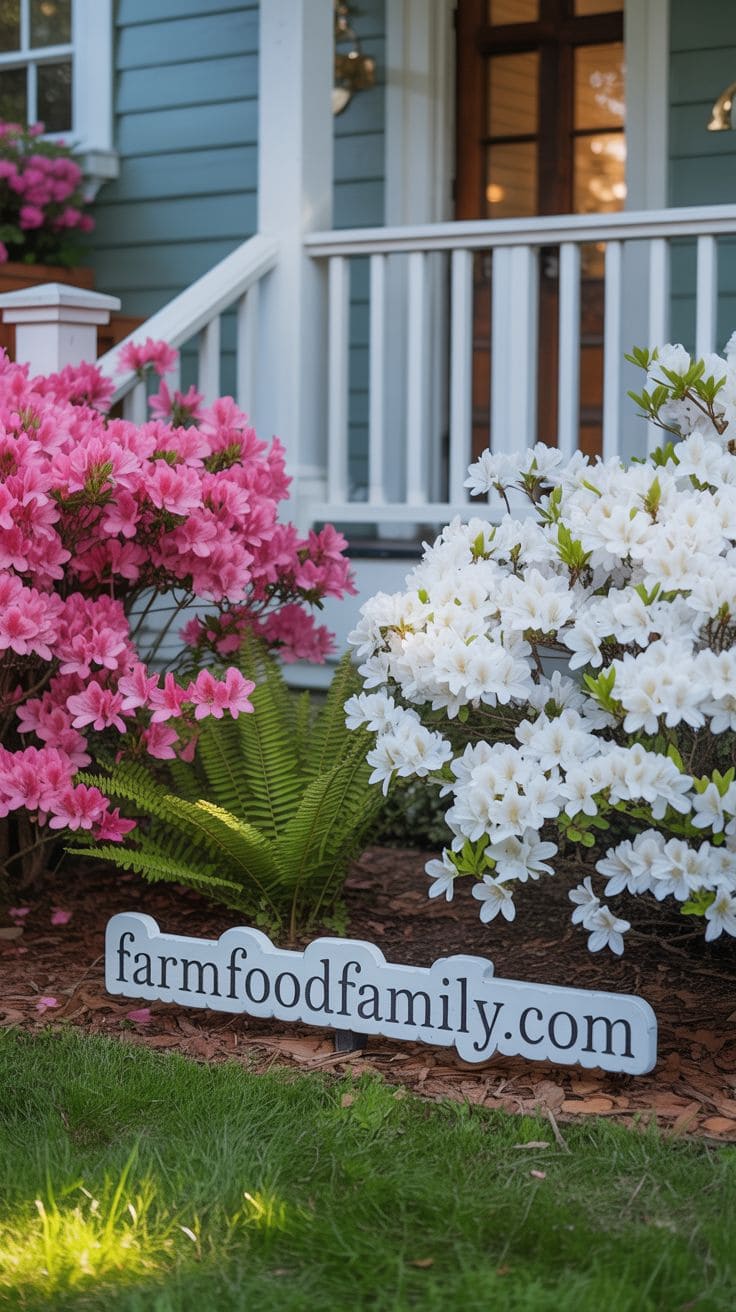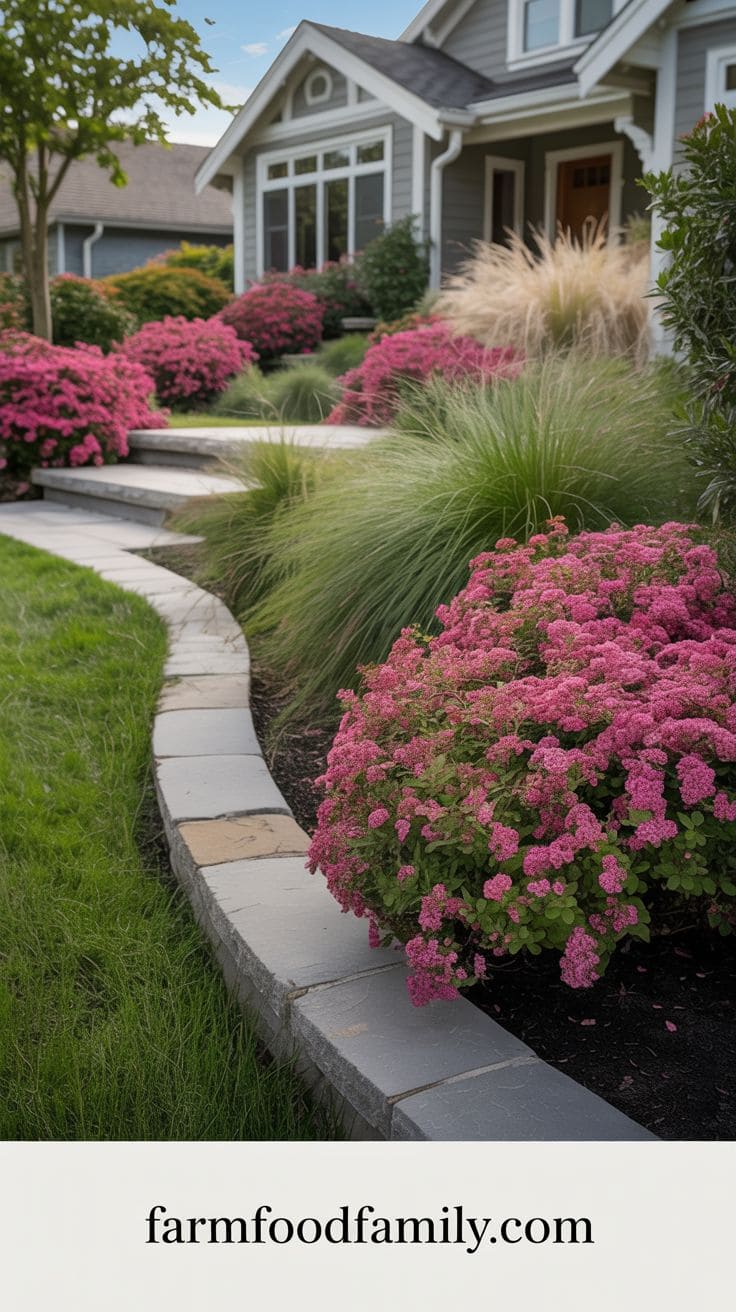Shrubs are a cornerstone of front yard landscaping, offering year-round structure, curb appeal, and low-maintenance beauty. They frame your home, define pathways, and soften architectural edges while anchoring other plantings like perennials or annuals.
The right shrubs can provide seasonal interest through flowers, foliage, or even berries as they’re helpful with inviting pollinators and birds to your garden space. Shrubs come in a wide variety of textures, sizes, and colors to complement your home’s facade.
The following shrubs for front of house ideas offer a thoughtful mix of ornamental and practical options that can dramatically transform your front yard’s appearance while being beautiful and functional.

1. Boxwood Borders for A Classic Foundation

Boxwoods are timeless, evergreen shrubs that make excellent front-of-house landscaping. Their dense foliage and slow growth make them ideal for creating low borders or structured accents near windows.
You can shape them into spherical balls, square hedges, or leave them to grow organically for a softer look.
Boxwoods look great in both formal landscapes and more casual cottage settings, especially when combined with flowering plants like hydrangeas or lavender.
They keep their lush green color all year and are extremely resistant to pruning, making them ideal for delineating walkways, anchoring flower beds, or flanking an entryway with balanced precision.



2. Hydrangea Shrubs for Seasonal Color and Volume

If you’re searching for eye-catching blossoms, hydrangeas have lush, full-bodied flowers that make an immediate impression.
Planted in a row or in groups, they thrive in partial sun and bloom from late spring to summer.
The blossom color varies according to the soil pH, ranging from blue and purple to pink and white, allowing for more color coordination.
Their big, textured leaves lend visual weight, making them ideal companions for finer foliage or evergreen shrubs.
They perform well under porch windows, along walks, and as anchor points in front beds. Choose cultivars with striking colors to leave a lasting impression on all of your visitors and neighbors.



3. Azaleas for Springtime Charm

Azaleas provide a burst of color in early to mid-spring with their profuse blooms in pink, red, white, or purple.
Their small stature makes them excellent for planting near windows or along entryways, where they can serve as seasonal highlights.
When they aren’t blooming, they maintain a clean and bushy appearance with green or semi-evergreen foliage.
Azaleas thrive in slightly acidic soil and partial shade, making them ideal for east-facing homes.
They appear best when planted in groups of threes or staggered across curving beds, surrounded by mulch and similar foliage plants. Their colorful blossoms create a pleasant and soothing image.



4. Spirea for Simple Color and Texture

Spirea shrubs are noted for their low-maintenance nature and eye-catching blooms, which can be pink, white, or red depending on the type.
These deciduous shrubs have attractive fall foliage that becomes bronze or reddish-orange, providing interest throughout the year.
Compact variants are appropriate for front beds with little space. Their rounded shape provides softness, and the bright, airy blossoms contrast well with bolder evergreens or dark mulch.
Spirea is drought-tolerant, thrives in full sun, and requires little maintenance, making it excellent for busy homeowners seeking visual impact without trouble.



5. Nandina for Airy Elegance and Seasonal Shifts

Nandina, often known as “Heavenly Bamboo,” is a versatile shrub with fern-like foliage, white spring flowers, and red berries that grow in the fall. The foliage changes color throughout the year, making it a versatile choice for foundation planting.
Nandina’s upright growth habit and airy structure make it ideal for blending with denser plants to create contrast and movement.
It thrives in both full sun and moderate shade and can withstand drought once established.
Use it near the entrance or to fill in tiny spaces between windows for a naturally elegant, softly colored look. The berries are lovely, as is the foliage, and it offers good privacy for your front porch.









Thoughtfully chosen shrubs can transform the front of your house from a blank canvas into a welcoming, cohesive landscape that offers visual interest all year long. Whether your look is traditional or modern, there’s a perfect shrub combination to bring your vision to life.
The right shrubbery not only frames your house but also sets the tone for visitors, enhancing curb appeal while providing functional benefits like privacy and erosion control. If these ideas helped you out, leave a comment below and share the list with your friends!




